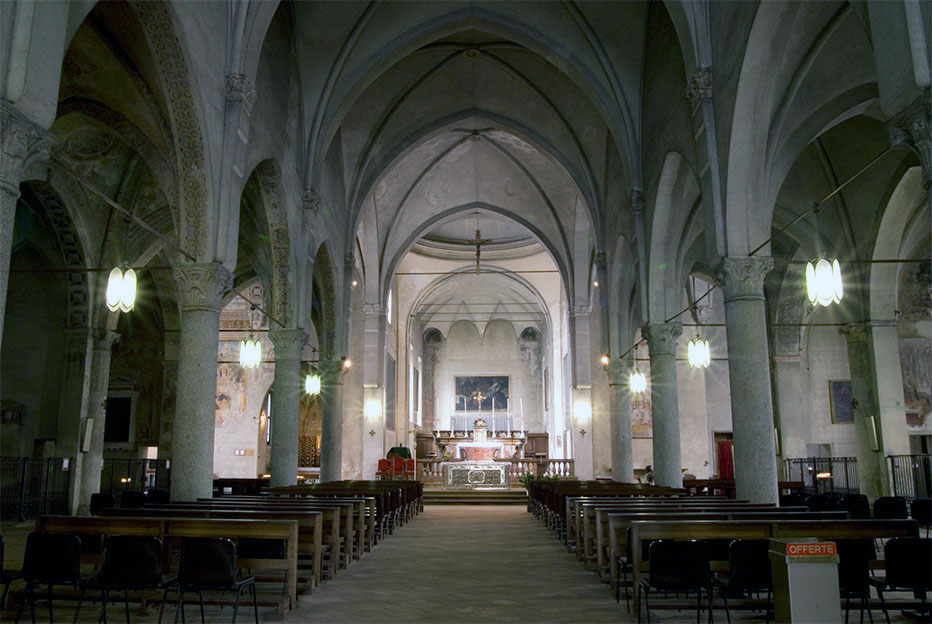Questa chiesa esisteva fin dal 1256 e dipendeva dall’ordine degli Umiliati. Passata ai Benedettini di S. Giustina di Padova, tra il 1447 e il 1475, con il contributo del banchiere fiorentino Pigello Portinari, si trasformò: venne eretta la “cappella maggiore” e vennero aggiunte altre cappelle. Le trasformazioni più vistose avvennero nel 1571, quando l’abate Orio allungò l’abside alla forma attuale, e nel 1640 quando l’abate Redaelli cambiò ancora l’aspetto della chiesa ampliando il presbiterio e alterando con forme barocche la vecchia forma del campanile. Nel 1912 toccò alla facciata, restaurata da Brioschi, ancora oggi con il portale barocco centrale, il finestrone ogivale e l’ingresso laterale barocco. Gravemente danneggiata nel 1943 dai bombardamenti, soprattutto nella navata destra con l’annesso convento, è stata poi ulteriormente restaurata. La chiesa è opera, forse, di Guiniforte Solari, e ha notevoli somiglianze con Santa Maria delle Grazie. L’interno è a croce latina, con tre navate divise in cinque arcate per lato che poggiano su colonne di granito con capitelli, con motivi vegetali. Le cappelle laterali sono a struttura poligonale con volte ad ombrello, contenenti esempi della pittura lombarda, bellissimi affreschi di A. Campi, un affresco del Bergognone che raffigura la cerimonia funebre per San Martino e una Adorazione dei Magi di G. B. Secchi. Notevole, inoltre, la cappella Grifi (fine del ’400), interamente ricoperta di affreschi dedicati alla vita di Sant’Ambrogio, opera di Bernardino Butinone e Bernardino Zenale. Del monastero presso la chiesa, fino ad una trentina di anni fa, rimanevano intatti i due chiostri cinquecenteschi, poi demoliti per far posto a nuove costruzioni. Esso fu sede, dal 1772 all’ultima guerra, dei Martinitt, istituzione sorta nel XVI secolo ad opera di Gerolamo Emiliani, fondatore dei padri Somaschi.

A church has stood on this spot since 1256, and originally belonged to the order of the Umiliati. After the suppression of the order it passed to the Benedictines of St Justina of Padua, and was transformed, between 1447 and 1475, with the financial contribution of the Florentine banker Pigello Portinari: the “main chapel” was erected and more side chapels were added. More grandiose transformations took place beginning in 1571, when the abbot Orio extended the apse to its present form, and in 1642 when the abbot Redaelli changed the appearance of the church again, enlarging the presbytery and giving a new Baroque form to the old belltower. In 1912 the façade was restored by Brioschi, though even today it maintains its Baroque central door, its ogival window, and the Baroque side entrance. Gravely damaged in the bombardments of summer 1943, above all in the right-hand aisle and the attached convent, it was subsequently restored. The church is perhaps the work of the architect Guiniforte Solari, and has notable similarities to Santa Maria delle Grazie. The interior is a Latin cross, with a nave and two side aisles divided by five arches per side which rest on granite columns whose capitals are decorated with plant forms. The side chapels have a polygonal structure with umbrella vaults, containing examples of Lombard painting, beautiful frescoes by Antonio Campi, a fresco by Bergognone that depicts the funeral of St Martin, and an Adoration of the Magi by Giovanni Battista Secchi. The Grifi chapel (from the end of the fifteenth century) is notable as it is entirely covered in frescoes dedicated to the life of St Ambrose, a work of the painters Bernardino Butinone and Bernardino Zenale. Two sixteenth-century cloisters remained from the old monastery attached to the church until the 1970s, when they were senselessly demolished in favour of the anonymous new constructions that flank the church. The monastery had been, from 1772 until the last war, the seat of the Martinitt, an institution from the sixteenth century created by Gerolamo Emiliani, the founder of the Somaschi fathers.

Basilica di Santa Maria della Passione
via Conservatorio 16 MM San Babila, tram 9, 23, bus 54, 61, 94
Sala Capitolare del Bergognone
via Conservatorio 16 MM San Babila, tram 9, 23, bus 54, 61, 94
Chiesa di San Sepolcro (Biblioteca Ambrosiana)
piazza San Sepolcro MM Duomo, tram 1, 2, 3, 12, 14, 15, 16, 24, 27
Chiesa di San Bernardino alle Monache
via Lanzone 13 MM S. Ambrogio, tram 2, 14, bus 50, 58, 94
Basilica di San Simpliciano
piazza San Simpliciano MM Lanza/Moscova, tram 2, 4, 12, 14, bus 43, 57, 61, 94
Chiesa di Santa Maria Annunciata in Chiesa Rossa
via Montegani angolo via Neera, MM Abbiategrasso, tram 3, 15
bus 65, 79, 95
Chiesa di Sant’Alessandro
piazza Sant’Alessandro, MM Missori, tram 2, 3, 12, 14, 15, 16, 24, 27
Chiesa di San Nicolao della Flue
via Dalmazia 11, tram 27, bus 45
Basilica di San Babila
piazza San Babila, MM San Babila, bus 54, 60, 61, 73, 94
Basilica di San Vincenzo in Prato
piazzetta Beria di Argentine angolo via S. Calocero, MM S. Agostino tram 2, 10, 14, bus 74, 94
Chiesa di San Pietro in Gessate
piazza San Pietro in Gessate, MM San Babila, tram 9, 12, 23, 27
bus 60, 65, 73, 84, 94
Coro di San Maurizio al Monastero Maggiore
corso Magenta 13/15 MM Cadorna, tram 1, 4, 16, 27, bus 50, 57, 58, 61, 94
Basilica di Santa Maria delle Grazie
piazza Santa Maria delle Grazie MM Cadorna, tram 1, 16, 19, 27, bus 50, 58, 94
